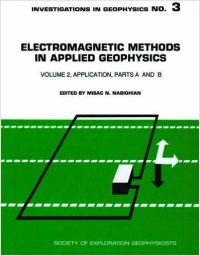
Ebook: Electromagnetic Methods in Applied Geophysics, Vol 2: Application / Parts A and B
- Tags: Mining Energy Production Extraction Engineering Transportation Geology Geomorphology Historical Limnology Physical Plate Tectonics Sedimentary Specific Locations Structural Volcanology Earth Sciences Science Math New Used Rental Textbooks Business Finance Communication Journalism Computer Education Humanities Law Medicine Health Reference Mathematics Social Test Prep Study Guides Specialty Boutique
- Series: Investigations in Geophysics 3
- Year: 2008
- Publisher: Society of Exploration
- Language: English
- pdf
Volume 2 covers, in depth, the physical basis of EM methods of exploration magnetometric resistivity method, profiling methods using small sources, large-layout harmonic field systems, EM soundings, time-domain EM prospecting methods, VLF, MT, CSAMT, airborne EM methods, borehole EM techniques, and electrical exploration methods for the seafloor. The material is divided into two volumes, Part A and Part B.
The scope of engineering seismology includes geotechnical site investigations for buildings and engineering infrastructures, such as dams, levees, bridges, and tunnels, landslide and active-fault investigations, seismic microzonation, and geophysical investigations of historic buildings. These projects require multidisciplinary participation by the geologist, geophysicist, and geotechnical and earthquake engineers. Read more...
The scope of engineering seismology includes geotechnical site investigations for buildings and engineering infrastructures, such as dams, levees, bridges, and tunnels, landslide and active-fault investigations, seismic microzonation, and geophysical investigations of historic buildings. These projects require multidisciplinary participation by the geologist, geophysicist, and geotechnical and earthquake engineers. Read more...
Abstract: The scope of engineering seismology includes geotechnical site investigations for buildings and engineering infrastructures, such as dams, levees, bridges, and tunnels, landslide and active-fault investigations, seismic microzonation, and geophysical investigations of historic buildings. These projects require multidisciplinary participation by the geologist, geophysicist, and geotechnical and earthquake engineers. A key objective of this book (SEG Investigations in Geophysics Series No. 17) by Öz Yilmaz is to encourage the specialists from these disciplines to apply the seismic method to solve the many challenging engineering problems they face. The broader scope of engineering seismology also includes exploration of earth resources, including groundwater exploration, coal and mineral exploration, and geothermal exploration. While focusing on the application of the seismic method to geotechnical site investigations, this book includes many case studies in all of the applications of engineering seismology